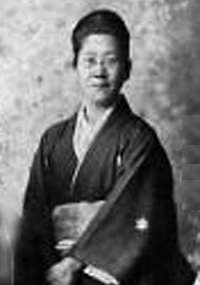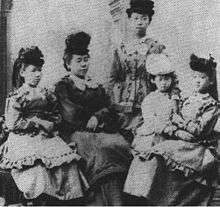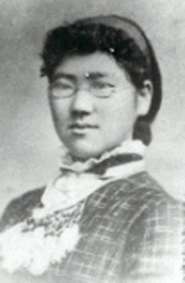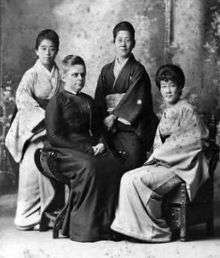Uryū Shigeko
| Baroness Uryū Shigeko | |
|---|---|
| 瓜生 繁子 | |
 Uryū Shigeko, in her later years | |
| Personal details | |
| Born |
Masuda Shige (益田 しげ) April 18, 1862 Edo, Japan |
| Died |
November 3, 1928 (aged 66) unknown |
| Nationality | Japanese |
| Spouse(s) | |
| Father | Masuda Takayoshi |
| Relatives | Masuda Takashi (brother) |
| Education | Certificate in Music |
| Alma mater |
Vassar College Vassar School of Art |
| Occupation | Educator, piano instructor |
| Profession | Music |
| Known for | one of the first women piano teachers in Japan |
| Other names |
Nagai Shige (永井 しげ) Nagai Shigeko (永井 繁子) |
Baroness Uryū Shigeko (瓜生 繁子 18 April 1862 – 3 November 1928), (née Masuda (益田) and later Nagai (永井)), was a Japanese educator and one of the first women piano teachers in Japan to teach Western classical music.
Biography
Masuda Shige (益田 しげ) was born in Edo on 18 April 1862, one of the four daughters of Masuda Takayoshi, a Sado bugyō.[1]
She was the younger sister of Masuda Takashi.[2] She was later adopted to the family of Nagai Gen'ei or his son Kyūtarō and was known as Nagai Shige.[3]


In November 1871 at the age of only 10 years old, Nagai Shigeko was among the five Japanese girls sent to the United States as part of the Iwakura Mission. In September 19, 1878, she entered the School of Art at Vassar College and studied music for three years[4][5]
After graduating from Vassar and returning to Japan in 1881, she married Baron Uryū Sotokichi in 1 December 1882 and was made a Baroness. Baroness Uryū Shigeko served as a teacher at the Tokyo Music School and Tokyo Women's Normal School.[6][7]
She died on 3 November 1928.

See also
References
- ↑ 全国版幕末維新人物事典 (in Japanese). 2010. p. 319.
- ↑ Japanese culture in the Meiji Era. 3. 1969. p. 471.
- ↑ Mitteilungen der Deutschen Gesellschaft für Natur- und Völkerkunde Ostasiens [Messages of the German Society for Nature and Ethnology of East Asia] (in German). 145. 2007. p. 166.
- ↑ "Baroness Uriu". Vassar College. 2007. Retrieved 17 November 2017.
- ↑ Sant, Van John; Mauch, Peter; Sugita, Yoneyuki (1 March 2010). The A to Z of United States-Japan Relations. Scarecrow Press. p. 185.
- ↑ Bulletin - Council for Research in Music Education. University of Illinois. 1994. p. 103.
- ↑ Nimura, Janice P. (2015). Daughters of the Samurai: A Journey from East to West and Back. New York: W. W. Norton. ISBN 978-0-393-35278-8.